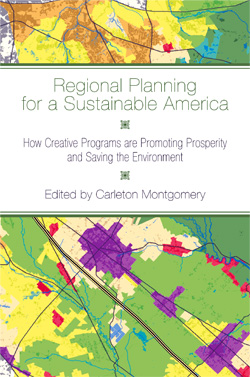The Columbia River Gorge National Scenic Area is an outstanding example of regional planning arising out of federal/state and interstate cooperation. The National Scenic Area includes portions of Oregon and Washington states, and the U.S. Forest Service has extensive land holdings within the Scenic Area. The initiative was bitterly opposed by many residents and politicians when it was launched (or, in the view of its opponents, imposed) in 1986, but the benefits it has brought the region over the past twenty years have won it widespread public support.
The Columbia River Gorge National Scenic Area is a rural area pressed by sprawl emanating from cities outside its boundaries (in this case Portland and Vancouver). Special federal legislation designated the National Scenic Area and directed the U.S. Department of Agriculture’s Forest Service to work with a Commission appointed by the states of Washington and Oregon to manage the region’s growth and conservation. The management plan is detailed and mandatory, but it relies first and foremost on the county governments to adopt its terms and ensure it is implemented within their jurisdictions. Columbia River Gorge is America’s only “national scenic area” (the many National Heritage Areas are similar in concept, but are administered by the Interior Department’s National Park Service). The program’s success suggests other regions should consider the kind of federal sponsorship and cooperative land use planning this initiative is achieving.
Vital Statistics:
Chapter of the Book: 2
States: OR & WA
Year Established: 1986
Geographic Scale: 292,500 acres
Mandatory or Voluntary over Local Government: Mandatory
Authorizing Laws: Federal & State
Agencies and Organizations:
Columbia River Gorge Commission
Resources:
Columbia River Gorge Compact (Oregon and Washington statutes)
Columbia River Gorge National Scenic Area Act, 16 U.S.C. 544
Columbia River Gorge Commission Land Use Ordinance
Columbia River Gorge Commission GIS resources
Selected References:
Abbott, C., S. Adler and & M.P. Abbott. 1997. Planning a New West: The Columbia River Gorge National Scenic Area. Oregon State University Press.
Allen, J. 1984. The Magnificent Gateway: A Layman’s Guide to the Geology of the Columbia River Gorge. Timber Press.
Blair Jr., B. 1986. The Columbia River Gorge National Scenic Area: The Act, Its Genesis and Legislative History. Environmental Law. 17:863-969.
Blumm, M. and J. Smith. 2006. Protecting the Columbia River Gorge: A Twenty-Year Experiment in Land-Use Federalism. Journal of Land Use and Environmental Law. Spring 2006 21:201-232.
Green, M. 2006. Causes of Haze in the Gorge: Final Report Submitted to Southwest Clean Air Agency and Oregon Department of Environmental Quality. Desert Research Institute, University of Nevada.
Williams, C. 1980. Bridge of the Gods Mountains of Fire: A Return to the Columbia Gorge. New York: Friends of the Earth.

